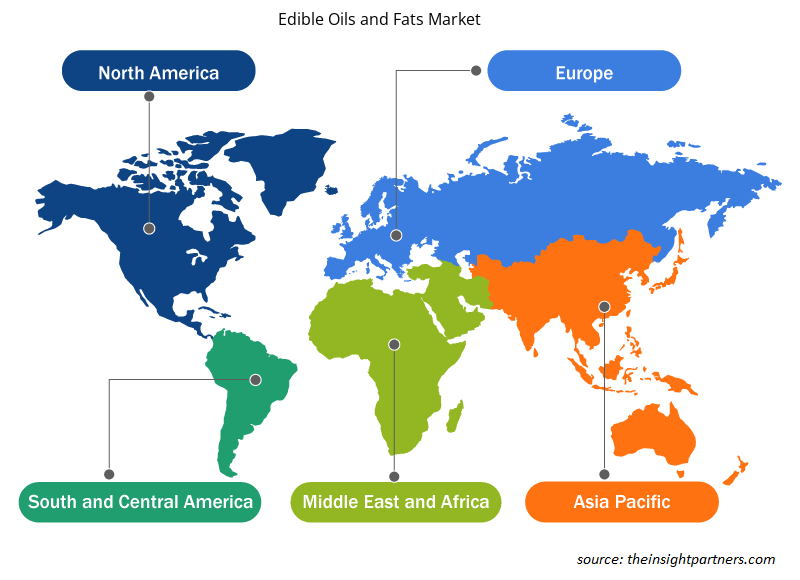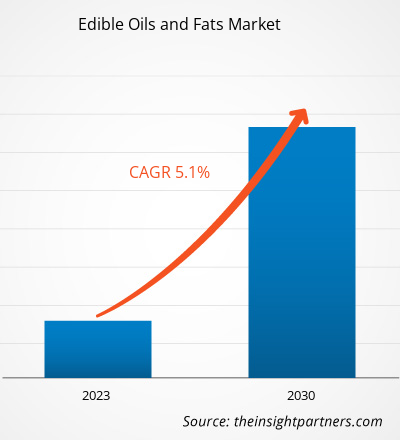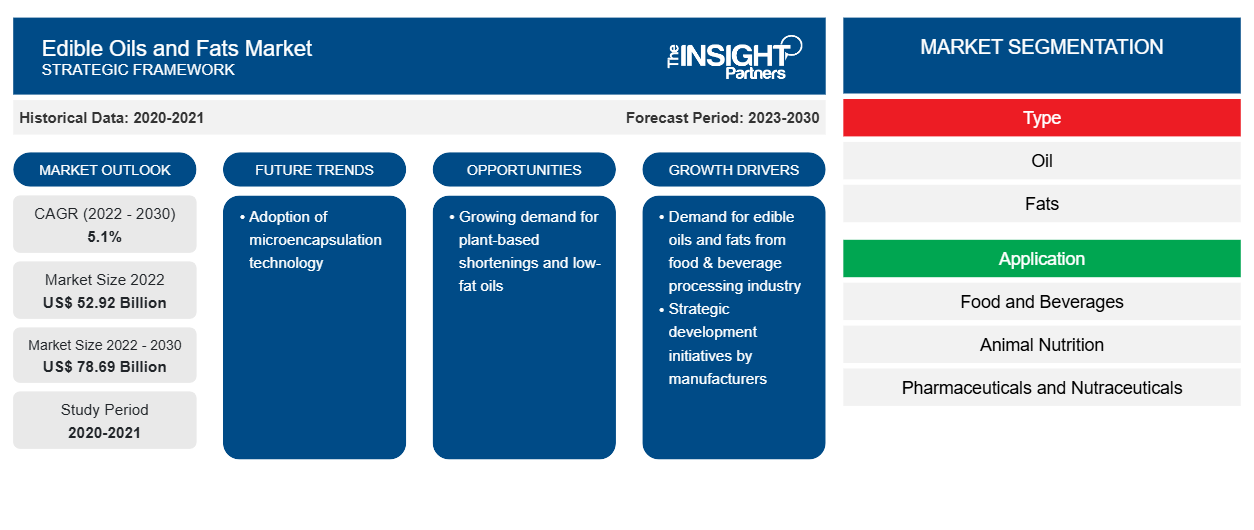[연구보고서] 식용유지 시장은 2022년 529억2,000만달러에서 2030년 786억8,661만달러로 성장할 것으로 예상되며, 2023년에서 2030년까지 연평균 성장률 5.1%를 기록할 것으로 예상됩니다.
시장 통찰력 및 분석가 관점:
식용 지방은 돼지기름(라드)과 탤로우와 같은 동물성 원료나 식물성 원료를 통해 얻습니다. 육류 가공업체는 식용 동물성 지방 제조업체의 원료 공급업체입니다. 제조업체는 육류 가공 산업과 원료를 중단 없이 공급하기 위한 장기 계약을 맺습니다. 돼지고기나 소고기의 지방 조직은 작은 조각으로 잘게 자르고 증기 소화조에서 끓입니다. 여기서 지방은 물에 방출됩니다. 지방은 수면 위로 떠서 스키밍으로 수집합니다. 동물 조직의 막질 물질은 유압 프레스에서 압착하여 추가 지방을 얻습니다. 지방은 슬러지 제거 원심분리기에서 액체 상태에서 분리됩니다.
마가린과 같은 식물성 지방은 대두유, 옥수수유 또는 홍화유의 수소화에 의해 얻어진다. 기름은 먼저 표백토 또는 숯으로 표백하여 바람직하지 않은 냄새와 색상을 제거한다. 그런 다음 고압 하에 수소 가스를 통과시켜 기름을 응고시켜 마가린을 얻는다. 식물성 기름과 지방을 제조하는 데는 다양한 공정이 있다.
정제된 식용 오일과 지방은 용기에 포장되어 유통업체와 공급업체를 통해 식품 및 음료, 동물 영양, 제약 및 건강기능식품 산업과 같은 최종 사용자에게 배송됩니다. Cargill Incorporated, Bunge Limited, ADM, Fuji Oil Co Ltd, Kao Corporation은 전 세계적으로 식용 오일과 지방의 주요 제조업체 중 일부입니다.
성장 동인 및 과제:
미국 농무부(USDA)에 따르면 대두유는 두 번째로 많이 소비되는 식물성 기름입니다. 튀김, 조리, 쇼트닝, 마가린에 광범위하게 사용됩니다. 경제협력개발기구(OECD)에 따르면 2022년 식물성 기름 소비량은 2억 4,900만 톤에 달했으며, 식품 부문이 가장 큰 비중을 차지했습니다. 게다가 제과 산업은 버터를 주요 성분으로 상당히 활용하고, 그 다음은 마가린입니다. 고품질 식용유와 지방은 제빵 및 제과, 유제품 및 냉동 디저트, 간식, 바로 먹을 수 있는(RTE) 및 바로 조리할 수 있는(RTC) 식사, 기타 식품 및 음료에 사용됩니다. 정제된 기름과 지방은 지질의 풍부한 공급원입니다. 따라서 응용 분야가 증가하고 세계 인구가 증가함에 따라 사용이 증가하고 있습니다.
북미와 아시아 태평양과 같은 다양한 지역의 식품 및 음료 산업은 지속 가능성에 대한 급증하는 경향, 편의성 및 바로 먹을 수 있는 제품에 대한 선호도, 유기농 및 식물성 제품의 증가로 인해 지속적으로 성장하고 있습니다. 이 산업은 빠르게 변화하는 소비자 선호도에 부응하기 위해 프로세스, 제품 및 서비스의 혁신으로 상당한 움직임을 목격하고 있습니다. 미국 인구조사국에 따르면 미국은 2020년에 39,646개의 식품 및 음료 제조 공장을 보유하고 있었습니다. 그 중 캘리포니아, 텍사스 및 뉴욕은 각각 6,116개, 2,625개 및 2,600개를 보유하고 있습니다. 마찬가지로 식품 및 음료 산업은 유럽 경제에 크게 기여하는 산업 중 하나입니다. 따라서 전 세계적으로 성장하는 식품 및 음료 산업은 식용 오일과 지방에 대한 수요를 촉진합니다.
귀하의 요구 사항에 맞게 이 보고서를 사용자 정의하세요
이 보고서의 일부 또는 국가 수준 분석, Excel 데이터 팩을 포함하여 모든 보고서에 대한 사용자 정의를 무료로 받을 수 있으며 신생 기업 및 대학을 위한 훌륭한 혜택과 할인 혜택을 이용할 수 있습니다.
-
이 보고서의 주요 시장 동향을 알아보세요.이 무료 샘플에는 시장 동향부터 추정 및 예측까지 다양한 데이터 분석이 포함됩니다.
보고서 세분화 및 범위:
"글로벌 식용유 및 지방 시장 "은 유형, 응용 분야 및 지리적 위치에 따라 세분화됩니다. 유형에 따라 시장은 오일과 지방으로 나뉩니다. 응용 분야에 따라 글로벌 식용유 및 지방은 식품 및 음료, 동물 영양, 제약 및 건강 보조 식품으로 나뉩니다. 오일 세그먼트는 글로벌 시장에서 더 큰 점유율을 차지했습니다.
식용유지 시장
2022년에 식용유 및 지방 시장은 지리적으로 북미(미국, 캐나다, 멕시코), 유럽(독일, 프랑스, 이탈리아, 영국, 러시아, 유럽의 나머지 지역), 아시아 태평양(호주, 중국, 일본, 인도, 한국, 아시아 태평양의 나머지 지역), 중동 및 아프리카(남아프리카, 사우디 아라비아, UAE, 중동 및 아프리카의 나머지 지역), 남중부 아메리카(브라질, 칠레, 남중부 아메리카의 나머지 지역)로 세분화됩니다.
세그먼트 분석:
식용유와 지방 시장은 유형에 따라 오일과 지방으로 나뉩니다. 오일 세그먼트는 2022년 식용유와 지방 시장에서 더 큰 점유율을 차지했으며 예측 기간 동안 더 높은 CAGR을 기록할 것으로 예상됩니다. 식물성 오일은 씨앗, 곡물, 견과류 및 과일에서 얻을 수 있습니다. 올리브, 해바라기, 팜, 카놀라, 코코넛, 홍화, 옥수수, 땅콩, 면실, 팜핵 및 대두유는 가장 많이 소비되는 오일 중 일부입니다. 일반적으로 식물성 오일은 식품 준비에 사용되고 원유는 풍미를 위해 추가됩니다. 식물성 오일은 또한 동물 사료 생산에도 사용됩니다. 팜유는 안정화하기 쉽고 가공 식품에서 풍미 품질과 일관성을 유지합니다. 따라서 식품 제조업체에서 자주 선호합니다. 인도네시아, 말레이시아, 태국 및 나이지리아는 가장 큰 팜유 생산자 및 수출국 중 일부입니다. 수소화 식물성 오일의 트랜스 지방과 관련된 건강 문제에 대한 인식이 높아짐에 따라 식품 산업에서 팜유 사용이 촉진됩니다. 농식품 산업은 팜유의 상당한 소비자로, 주로 산업용 제빵류, 초콜릿 제품, 과자, 아이스크림, 심지어 다이어트 식사 대용품에 사용되기 때문입니다. 팜유는 토코페롤과 카로티노이드의 풍부한 공급원으로, 산화적 열화에 대한 자연적 안정성을 제공합니다. 따라서 다양한 최종 사용 산업에서 팜유의 이점과 용도가 전 세계적으로 수요를 촉진합니다.
지역 분석:
식용유 및 지방 시장은 북미, 유럽, 아시아 태평양, 남미 및 중미, 중동 및 아프리카의 5개 주요 지역으로 세분화됩니다. 글로벌 식용유 및 지방 시장은 남미 및 중미가 주도했으며 2022년에는 약 4조 5,000억 달러로 추산되었습니다. 남미 및 중미의 식용유 및 지방 시장은 브라질, 아르헨티나, 그리고 남미 및 중미의 나머지 지역으로 세분화됩니다. 이 지역의 간식 식품 부문은 냉동 간식, 짭짤한 간식, 과일 간식, 과자 간식, 베이커리 간식과 같은 다양한 간식 옵션에 대한 소비자 선호도가 높아짐에 따라 확대되고 있습니다. 식용유 및 지방은 음식에 독특한 풍미를 제공하고 간식을 제조하는 데 독특하고 바람직한 기능을 제공하므로 필수적인 역할을 합니다. 예를 들어, 기름은 튀긴 음식의 튀김 매체이며, 페이스트리에서는 밀가루와 기타 재료가 뭉치는 것을 방지하기 위해 식물성 기름 기반 쇼트닝을 첨가합니다. 따라서 다양한 간식에 대한 수요가 증가하고 식용유와 지방이 지닌 이점으로 인해 남미와 중미의 간식 부문에서 식용유와 지방에 대한 수요가 증가하고 있습니다.
또한 동물 영양과 같은 최종 사용 산업에서 식용 유지에 대한 수요는 남미와 중미에서 증가했습니다. Oil World에 따르면, 2022년에 중국은 브라질 대두유의 약 70%를 주로 동물성 단백질 소비를 위해 구매했습니다. 또한 동물 영양, 제약 및 건강기능식품 산업의 확대로 인해 특수 식용 유지에 대한 수요가 증가하고 있습니다. 이러한 산업은 동물 사료 제형 및 제약 제형과 같이 다양한 용도에 특정 유형의 오일이 필요합니다. 이러한 부문이 성장하고 다양화됨에 따라 고유한 요구 사항에 대한 수요가 증가하여 남미와 중미의 식용 유지 시장 성장을 촉진합니다.
산업 발전 및 미래 기회:
글로벌 식용유 및 지방 시장에서 활동하는 주요 기업이 취한 다양한 이니셔티브는 아래와 같습니다.
- 2021년 10월, 미국의 대표적인 식용 유지 제조업체 중 하나인 ADM은 식품 및 사료 산업에서 빠르게 증가하는 대두유 수요를 충족하기 위해 노스다코타에 최초의 전용 대두 분쇄 공장과 정유 공장을 건설할 계획이라고 발표했습니다.
- 2021년 12월, 일본에 본사를 둔 ITOCHU Corporation은 미국 뉴욕에 본사를 둔 ITOCHU International Inc.를 통해 미국에 Fuji Oil International Inc.를 설립하기로 합의했다고 발표했습니다. 이 합의를 통해 회사는 북미에서 오일 및 지방 사업을 강화할 계획입니다.
식용유 및 지방 시장 지역 통찰력
Insight Partners의 분석가들은 예측 기간 동안 식용유 및 지방 시장에 영향을 미치는 지역적 추세와 요인을 철저히 설명했습니다. 이 섹션에서는 북미, 유럽, 아시아 태평양, 중동 및 아프리카, 남미 및 중미의 식용유 및 지방 시장 세그먼트와 지리에 대해서도 설명합니다.

- 식용유 및 지방 시장에 대한 지역별 특정 데이터 얻기
식용유 및 지방 시장 보고서 범위
| 보고서 속성 | 세부 |
|---|---|
| 2022년 시장 규모 | 529억 2천만 달러 |
| 2030년까지 시장 규모 | 786억 9천만 달러 |
| 글로벌 CAGR (2022-2030) | 5.1% |
| 역사적 데이터 | 2020-2021 |
| 예측 기간 | 2023-2030 |
| 다루는 세그먼트 |
유형별로
|
| 포함된 지역 및 국가 |
북아메리카
|
| 시장 선도 기업 및 주요 회사 프로필 |
|
시장 참여자 밀도: 비즈니스 역학에 미치는 영향 이해
식용유 및 지방 시장은 소비자 선호도의 변화, 기술 발전, 제품의 이점에 대한 인식 증가와 같은 요인으로 인해 최종 사용자 수요가 증가함에 따라 빠르게 성장하고 있습니다. 수요가 증가함에 따라 기업은 제품을 확장하고, 소비자의 요구를 충족하기 위해 혁신하고, 새로운 트렌드를 활용하여 시장 성장을 더욱 촉진하고 있습니다.
시장 참여자 밀도는 특정 시장이나 산업 내에서 운영되는 회사나 기업의 분포를 말합니다. 주어진 시장 공간에 얼마나 많은 경쟁자(시장 참여자)가 존재하는지 그 규모나 총 시장 가치에 비해 나타냅니다.
식용유와 지방 시장에서 활동하는 주요 회사는 다음과 같습니다.
- 번지 유한회사
- 아처-대니얼스-미들랜드 카운티
- 후지 오일 주식회사
- 카오 주식회사
- 아케이에이치에이치에이
면책 조항 : 위에 나열된 회사는 어떤 특별한 순서에 따라 순위가 매겨지지 않았습니다.

- 식용유 및 지방 시장의 주요 주요 업체 개요를 알아보세요
COVID-19 팬데믹 영향:
COVID-19 팬데믹은 다양한 국가의 경제와 산업에 영향을 미쳤습니다. 북미, 유럽, 아시아 태평양(APAC), 남미 및 중미, 중동 및 아프리카(MEA)의 주요 국가에서 봉쇄, 여행 금지 및 사업 중단은 식품 및 음료 산업을 포함한 다양한 산업의 성장에 부정적인 영향을 미쳤습니다. 제조 단위의 폐쇄는 글로벌 공급망, 제조 활동, 납품 일정 및 다양한 필수 및 비필수 제품의 판매를 방해했습니다. 다양한 회사에서 2020년에 제품 납품이 지연되고 향후 제품 판매가 침체될 가능성이 있다고 발표했습니다. 또한 유럽, 아시아 및 북미의 다양한 정부가 국제 여행에 대한 금지 조치를 취하면서 회사는 협력 및 파트너십 계획을 일시적으로 보류해야 했습니다. 이러한 모든 요인이 2020년과 2021년 초에 식품 및 음료 산업을 방해하여 식용유 및 지방 시장의 성장을 제한했습니다.
경쟁 환경 및 주요 회사:
Bunge Ltd, Archer-Daniels-Midland Co., Fuji Oil Co Ltd, Kao Corp, AAK AB, J-Oil Mills Inc, Cargill Inc, Olam Group Ltd, ConnOils LLC, Louis Dreyfus Co BV는 글로벌 식용유 및 지방 시장에서 활동하는 대표적인 기업입니다. 이러한 식용유 및 지방 제조업체는 혁신적인 기능을 갖춘 최첨단 추출 솔루션을 제공하여 소비자에게 뛰어난 경험을 제공합니다.
- 과거 분석(2년), 기준 연도, CAGR을 포함한 예측(7년)
- PEST 및 SWOT 분석
- 시장 규모 가치/거래량 - 글로벌, 지역, 국가
- 산업 및 경쟁 환경
- Excel 데이터세트
최근 보고서
관련 보고서
사용 후기
구매 이유
- 정보에 기반한 의사 결정
- 시장 역학 이해
- 경쟁 분석
- 고객 인사이트
- 시장 예측
- 위험 완화
- 전략 기획
- 투자 타당성 분석
- 신흥 시장 파악
- 마케팅 전략 강화
- 운영 효율성 향상
- 규제 동향에 발맞춰 대응























 무료 샘플 받기 - 식용유 및 지방 시장
무료 샘플 받기 - 식용유 및 지방 시장